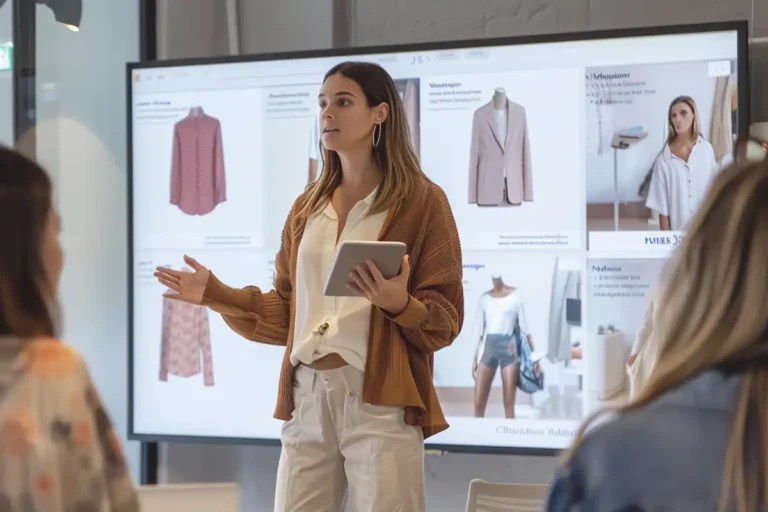
If you’ve ever walked into Monday morning trade meeting clutching your sales reports and hoping the questions stay away from your category — you are not alone.
Every Assistant Buyer and Junior Buyer has been there, and has felt that same mix of anticipation and dread. This is especially true in fast-paced retail where the calendar moves quickly, margin pressures are real, and every decision connects directly to customer spend.
What I can say after many years of experience is that confidence in these meeting comes from the preparation you do beforehand. It may feel like everyone else is gliding through decisions with complete certainty. But here’s the real truth:
In fashion buying, confidence is built through experience, being prepared and learning how to analyse, not just execute.
Yes, you need product instinct. Yes, you need trend awareness. But what actually makes you confident? It is knowing how to deliver the perfect product and commercial mix. It’s about understanding the numbers and knowing the “why” behind every choice.
Below, I’ll share some practical habits that will help you to build confidence and the real-world stories behind them so you can feel more prepared, more influential, and more in control in your buying role.
Your Monday Trade Meeting Prep Starts on Friday
In almost every buying office, Monday morning trade meetings are the heartbeat of the week. Its where the good news and (sometimes not so good news is reviewed), where numbers, strategy, and accountability meet.
But here’s an inside secret – The ‘one step ahead’ buyers don’t open the figures for the first time at 9 a.m. on Monday morning. They’ve already reviewed sell-throughs on Friday, checked which lines are overstocked, and made notes of key sales figures, and reactions. That prep means they walk into the trade meeting with less dread and ready to contribute.
The buyers who walk in calmly have not been in the office since 6:00 am but instead simply prepared when the office was quieter and their inbox wasn’t dictating their thinking.
So put a reminder in your calendar and make time for some prep on Friday – Here are some actions to take :-
- Look at top and bottom sellers ( quantities, colours and any interesting sales patterns)
- Check sell-through by option particularly for new lines that hit at the beginning of the week.
- Flag lines that are looking slow and showing a potential stock risk
- Scan web and competitor sites for price, colour, silhouette shifts
This isn’t difficult or complicated. It’s consistent.
A junior womenswear buyer told me recently: “I used to open the figures on Monday and panic. I didn’t know what I was supposed to look at. Once I started spending time on Friday reviewing my options and checking the ROS, I realised I knew more than I thought. Instead of sitting worrying all weekend about the Monday meetings I felt more confident and people noticed.”
Her role didn’t change. Her preparation did. And confidence followed. That prep means she walked into the trade meeting with less dread and ready to contribute.
The critical path in fashion buying rarely goes perfectly. Every season despite best efforts you will experience supplier delays, deliveries dates moving out, even weather changes can impact your plans. Over time you will notice the change in your confidence, how you can read your numbers more easily and explain the story your numbers are telling you.
Whether it’s why a new jersey top is over-performing or why that chunky knitwear style should have been phased in later. These are the nuggets of info that you spot and learn from. In turn these become the building blocks of confidence in your decision making.
Don't second guess : Be prepared
Navigating the Buying critical path is a business of variables from the weather, suppliers and stock flow to trend volatility and markdowns.
You can’t control every outcome. But you can control how informed you are. Remember that. Confidence comes from knowing your data and being able to justify your decisions calmly.
Key Data Buyers Should Know Weekly:
Metric | Why It Matters |
Sell-through % | Product performance & velocity |
Stock levels & cover | Ability to trade stock efficiently |
Markdown exposure | Financial risk & forecasting |
Newness sell-out | Product / Trend validation |
Best & worst options | Product learning and buy-plan insight |
When you can read your sales data and analyse why products sold as they did and say:
“This jersey top exceeded the sales targets due to its price positioning + launch timing; it has the potential for a wider colour assortment in the next drop”
It’s not about lucky guesses it is about being commercial and being prepared.

Learn from the Range Review Feedback
The Range sign-off is a key date in the buying office calendar. It can be nerve wrecking and there is a lot to prepare for but a range review is not a critique of you. It is an assessment of risk, volume balance, strategy, and customer needs.
If your Head of Buying says, “You are looking too heavy in dresses,” don’t take it personally; There is a reason this is being said. Sometimes when you are so focused on your product and range planning it can be easy to miss the bigger picture view. A menswear assistant once told me: “Every range review felt like a test. When my buyer pointed out my range plan was not ‘balanced’ I heard ‘you failed’. Once I started taking the feedback on board looking at the plan more objectively, by spotting duplication, colour repeats and price points imbalances I realised they were training me to see what they see.”
The moment you step out of your own way and change how you view feedback and interpret it as criticism to feedback equals clarity on how to think like a buyer, your confidence rises sharply.
After every key meeting, jot down three points: what worked, what didn’t, what to follow up. It turns learning into a habit. In fashion buying overtime you master these habits and these become instincts. Track what repeats across seasons Look for the patterns because that’s how your eye sharpens and you become a more confident and strategic buyer.
Find your Voice as a buyer
You don’t become commercially mature by working in isolation. Buying is a team effort and you learn through doing. Don’t be afraid to ask questions. Share your views and learn from your merchandisers and suppliers. Discuss what didn’t work and why.
Whe anticipated sales of a product don’t go as planned find out why.Ask your self some questions:“ What would we do differently next time?” You will learn more from an honest review than trying to apportion blame or excuses elsewhere.
Understanding the Context, Not Just Tasks
Early in your career, it’s easy to mistake different buying activities for development.
- Checking samples
- Processing orders
- Updating The Critical Path
- Chasing gold seals
- Writing product pages
All are necessary and part of the process to deliver your new ranges and collections to the shop floor. But not enough to make you a confident decision maker. Confidence comes from thinking, not just doing.
Here is the sort of strategic questions you should be able to answer.
- Why we need to buy into this trend now?
- What market knowledge or data supports this buy?
- How does this style impact our option count and weeks cover?
- How does our price point architecture support our market position?
- Does the MOQ for this line increase our any markdown risk?
Don’t make the false assumption “If I don’t speak, I won’t be wrong.” While Silence feels safe — but it keeps you invisible. Confidence is built by participating — even if imperfectly. You don’t need all the right answers. But you need to be willing to think commercially out loud.It can be easily to think “The buyer just knows instinctively.” In fact they don’t but They have patterns, experience, data and context. Every confident senior buyer has made mistakes before whether it was backing the wrong line, misreading a trend, ordering too deep on a quantity …. it happens.
The difference is seeing how they handle the situation now. They learned from past mistakes and have refined their decision making through repetition and understanding the sales data, not magic instinct or a crystal ball.
Confidence is the Outcome of Commercial Thinking
A former junior knitwear buyer shared this “I thought confidence meant having the answer. Eventually I realised it meant anticipating the questions and having the answers to back it up.
Once I started thinking like the buyer I aspired to be and not like an assistant my confidence levels changed completely.”
You are not expected to know everything in the early stages of your role as a buyer. But you are expected to prepare, contribute, learn, and think. You don’t need to be perfect at everything either. You need to master the process and ‘rinse and repeat ‘ !!
Confidence in fashion buying is the result of preparation, curiosity, and commercial discipline. Keep going. Every trade, every range review, every supplier call is building your buyer skillset and mastery.




